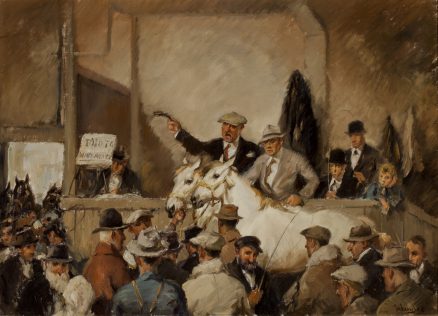- Categories
- Chicago places & people
- Immigrant artists
- Zoom in on Artwork
- Print Page
- Email Page to Friend
Walter Krawiec’s The Horse Auction makes the viewer a close-up spectator in a lively scene packed with traders and onlookers as an auctioneer calls the bids on a pair of white horses. The motley assortment of men crowding the foreground includes a bearded figure in a peaked cap, perhaps an immigrant, who turns away from the horses as he holds a whip upright. From the auctioneer’s enclosed platform, two well-dressed men and a girl in blue look on. At the left, more people cram into the space and the heads of several horses are silhouetted against the light from an open door.
With its loose brushwork and casually sketched figures, Krawiec’s image suggests on-the-spot reportage, perhaps reflecting the artist’s long experience as a newspaper cartoonist. He was also deeply familiar with the world of horses and the people who work with them, having become an artist in order to record the animals he had loved from boyhood. In the early 1930s Krawiec made a name for himself as a painter of horses at the circus in particular, and he also painted them at racetracks and polo grounds, on farms, pulling fire engines, and as recreational mounts. The horse auction seems to have been a singular subject, however, for only one known title for a Krawiec painting indicates such a setting: The Horse Auction, a work he exhibited in the Art Institute of Chicago’s 1941 annual “Chicago and Vicinity” show, is probably identical with this painting.
In the 1940s horse and other livestock auctions still took place at Chicago’s Union Stock Yards, as pictured by Francis Chapin in a painting and related lithograph made in the early 1930s. Krawiec’s auction, however, focuses on horses for show and recreation, as indicated by the beauty of the matched animals and the well-heeled aspect of the observers on the platform. From his childhood in a rural village in Poland to mid-twentieth-century Chicago, Krawiec witnessed the horse’s transition from a commonly seen work animal to a plaything of elite leisure.
Wendy Greenhouse, PhD
Donated by M. Christine Schwartz to the Polish Museum of America, Chicago, Illinois, in 2022
